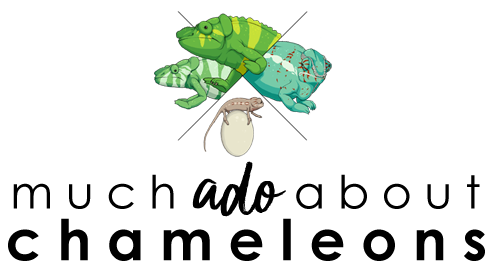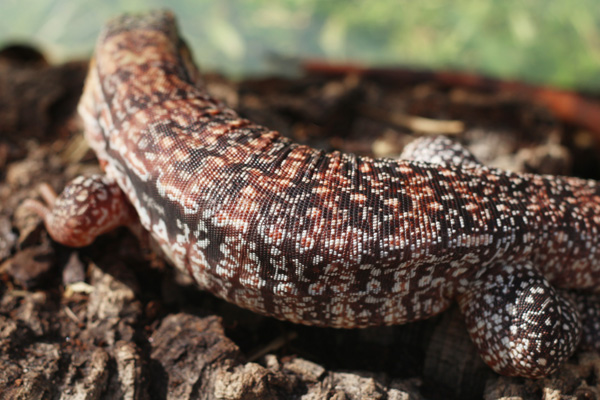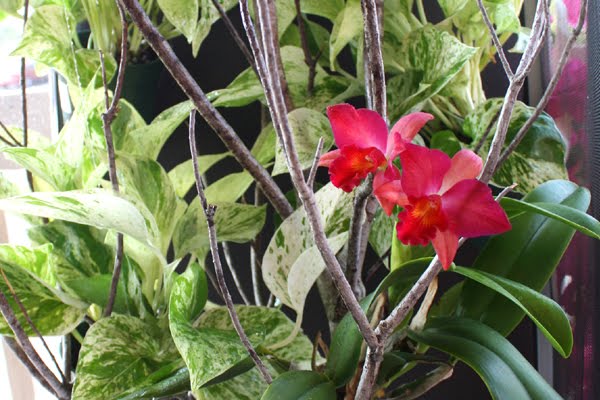 |
| Tiny baby, only 3 days old. |
The first baby panther from this clutch broke through the egg on October 5th, 2012 and remained there overnight until it finally hatched the next day. Babies will often break through the egg and lie there motionless with just their nose out for hours, if not days, at which point concerned owners think that the babies are dead. This is not necessarily the case, they are in the egg absorbing whatever may be left of their egg yolk and preparing themselves to emerge completely. I recommend not pulling or cutting them out of the egg, in case you injure them or tear their umbilicus, which could lead to an infection.
After the first neonate (or hatchling) emerged the others quickly followed. It is not unusual for baby chameleons to not eat for a few days after they hatch, so I did not immediately throw food into their cage, which for the first few weeks was a butterfly cage.
HOUSING | I love the butterfly cages because they zip closed and are of a very fine soft mesh, which means that their primary food source - fruit flies - would not be able to just climb out through the screen. I placed a tiny pothos plant in the center with a few small twigs and the babies lived happily in here for the first 3-4 weeks of their life. Because babies are so sensitive to temperature extremes, the butterfly cage mesh keeps the air circulating gently but does not allow it to dry out too quickly. Babies dehydrate faster than adult chameleons, so this is another reason you do not want to allow the temperatures to get too high.
I keep babies at an ambient room temperature of about 75F. No basking bulb at ALL at this point. But they did have a UVB bulb (a linear Reptisun 5.0 bulb) suspended above their cage (make sure there is shade in the baby cage to hide from the light if they need to, in my case I provided plants they could hide in.)
I keep babies at an ambient room temperature of about 75F. No basking bulb at ALL at this point. But they did have a UVB bulb (a linear Reptisun 5.0 bulb) suspended above their cage (make sure there is shade in the baby cage to hide from the light if they need to, in my case I provided plants they could hide in.)
The next step was to switch them over to a different cage once they were older, one where small insects like crickets or roaches would not be able to climb the sides to escape, so I chose to use a very large storage container without a top and provided a small ficus and twigs. I chose this method because I could move the whole container outside and the babies could stand on the ficus and get direct sunlight but their food could not escape.
WARNING: If doing any type of open top baby cage, make sure that everything is nice and far from the sides of the container! Babies are very light and have a surprising amount of reach, so they may be able to reach over and climb right out if sufficient care isn't taken.
You could very well use a traditional screen cage or a terrarium from the beginning, but I like the butterfly cage system and liked that small feeders could not escape the bin. An Exoterra terrarium would be fairly escape proof as well, however.
TEMPERATURE | Once the babies were older, about 2 months or so, I provided very gentle heat with a low-wattage incandescent bulb (about 25-40w), which was placed at an angle in one far corner of their cage, so they could get a proper temperature gradient. Even with the light their temperature never reached higher than 80F on the branches closest to the light, and the rest of the container stayed at about 73-75F, but it provided the extra heat if they needed it.
Like I said, babies are very sensitive to dehydration and high temperatures, so you want the ambient temperature to stay moderate. Forego a basking bulb entirely if your ambient temperatures are not in the 70-75F range, as a high ambient temperature can quickly kill an entire clutch from stress and dehydration. And keep any basking spot temperature very moderate as well, about 80F, but definitely not higher than that.
FEEDING & WATERING | The babies had access to food nearly all the time, as I would add feeders to the cage about 2-3 times a day, providing a multitude of pinhead crickets, fruit flies, and tiny roach nymphs. They were not given any worms because babies that eat worms may nip at their siblings' tails, confusing them as food. As they got older the size of their food also got a little bigger. I would supplement their food with a very light dusting of plain calcium, but at this point they were not getting any vitamins. They were also taken outside for natural sunshine nearly every day in the early morning and late evening, so between this and their UVB bulb they were getting all the vitamin D they could need.
I would mist them several times a day, taking care not to spray the hatchlings directly, getting the leaves of their little plants nice and wet. I would always check all the urates (the white part) on their poop to make sure that it was indeed white and not orange, which signals dehydration.
WARNING: If doing any type of open top baby cage, make sure that everything is nice and far from the sides of the container! Babies are very light and have a surprising amount of reach, so they may be able to reach over and climb right out if sufficient care isn't taken.
You could very well use a traditional screen cage or a terrarium from the beginning, but I like the butterfly cage system and liked that small feeders could not escape the bin. An Exoterra terrarium would be fairly escape proof as well, however.
TEMPERATURE | Once the babies were older, about 2 months or so, I provided very gentle heat with a low-wattage incandescent bulb (about 25-40w), which was placed at an angle in one far corner of their cage, so they could get a proper temperature gradient. Even with the light their temperature never reached higher than 80F on the branches closest to the light, and the rest of the container stayed at about 73-75F, but it provided the extra heat if they needed it.
Like I said, babies are very sensitive to dehydration and high temperatures, so you want the ambient temperature to stay moderate. Forego a basking bulb entirely if your ambient temperatures are not in the 70-75F range, as a high ambient temperature can quickly kill an entire clutch from stress and dehydration. And keep any basking spot temperature very moderate as well, about 80F, but definitely not higher than that.
FEEDING & WATERING | The babies had access to food nearly all the time, as I would add feeders to the cage about 2-3 times a day, providing a multitude of pinhead crickets, fruit flies, and tiny roach nymphs. They were not given any worms because babies that eat worms may nip at their siblings' tails, confusing them as food. As they got older the size of their food also got a little bigger. I would supplement their food with a very light dusting of plain calcium, but at this point they were not getting any vitamins. They were also taken outside for natural sunshine nearly every day in the early morning and late evening, so between this and their UVB bulb they were getting all the vitamin D they could need.
I would mist them several times a day, taking care not to spray the hatchlings directly, getting the leaves of their little plants nice and wet. I would always check all the urates (the white part) on their poop to make sure that it was indeed white and not orange, which signals dehydration.
 |
| One baby enjoying the Florida sunshine. |
By the time they turned 3 months old in early January they were ready to go to their new homes. As chance would have it, all but 1 of the offspring turned out to be female, and all of them grew relatively slowly. It is believed that Nosy Faly panthers take longer to grow and mature, so perhaps that percentage of their lineage was keeping them smaller. But I am certain that once spring comes they will really take off in growth. Below are a few photos of them as they were growing up.
Since I had so few hatchlings I never had to separate them into smaller groups, but if you find yourself with a large clutch it is better for their development to be divided into smaller numbers so that each one has less competition for resources. Keeping 30 hatchlings together, even with abundant food and water, always means that there will be bullying and stress for at least the smaller, weaker individuals. It is far better to divide them into groups of 10 or smaller, and keep dividing as they continue to grow and get bigger (and show attitude towards one another!)















sometimes on of my baby panthers are dark like black in color is that normal?
ReplyDeleteYes, that is pretty normal. They will darken up when they bask or if they get mad at any of their siblings.
DeleteYes it is normal because when the color of them chages black it just meens there in a bad mode thats all
DeleteIt is very normal dont worry they will change colors when there mood changes and when there black that meens there mad or stressed
DeleteHi olimpia, I was browsing the web and found your site. I need your help please. My husband bought a panther chameleon from Backwater Reptiles.com and days later he got a baby panther chameleon in the mail. Before he came to the house, we had his cage set up, lighting temperature, etc. The chameleon didn't eat the mealworms we supplied for him, but he would drink water. we observed him over the past week and he did not eat a single bug at all, and he eventually stopped drinking water. My husband is sad and worried that he will die soon. He's skinny, shedding, his eyes are sucked in slightly and he always looks tired. he also looks weak too. If you could help us out with some tips or information on why he could possibly be doing this, that would be very much appreciated. Thank you.
ReplyDeleteHi Kaimiloa,
DeleteDid you research prior to ordering your Panther chameleon? Mealworms are not a good food for them, they need baby crickets and hydei fruit flies. There are care sheets all over the internet that you can peruse.
If your chamileon is still a baby baby than your light you previded for him/her might be to hot which makes him/her sick
DeleteShedding is usually a good sign. It generally means the chameleon is growing. All the other signs seem like trouble. Hunger strikes are common but need to be taken seriously. A vet visit is in order. IMO
ReplyDeleteNice Blog!!
ReplyDeleteOlimpia I would advise you amend this article. I have had customers attempt to keep baby panthers this way due to this page with poor results (death). It is not your fault, but they went against what I said in favor of this article and it resulted in several dead chameleons. While YOU may know what you are doing, others do not - one altercation to this setup spells disaster for a baby. i.e. hot bulbs above or below, stale air sitting in the bin with no ventilation aside from the top. Using an exo terra eliminates these problems if variations are added.
ReplyDeleteYou might use a 40w bulb, but if someone combines this article with another care sheet they read that recommends 60w, then you're going to end up with baked chameleon. You might have a spacious room where temperature varies, others may have a closet where temperatures are too high. You might take them outside in this setup where ventilation is perfect, but many others would have them in a hot humid reptile room with little ventilation or ability to escape from the extremes. You may use live plants others may use fake. etc, etc, etc.
In my experience, people with little know-how of keeping young chameleons tend to bake them in this kind of setup whether it's a plastic tub or a glass aquarium. It is best to avoid this kind of setup altogether unless you are someone like Olimpia.
Again, not your fault, a lot of people read your blog for advice and I think this page in particular could use a little bit of fair warning if people add their own alterations.
What size butterfly cages did you use.
ReplyDeleteI used a couple that are a cube measuring I think either 12" or 14" on each side. I also had one that was about 2' high and 12" on each other measurement but I never got to use that one. I didn't have enough babies in the clutch to need it!
DeleteI was wondering if you have any pictures of your hatching set-ups with the butterfly cages? I was having difficulty figuring out a way to keep the flies in while providing circulating air. I did some research but there are many different types and I want to make sure I get ones that will work well. Also, I am a veterinarian that sees many exotic species (but I personally keep panthers) and I have a client that has two babies that will not switch over from flies to tiny crickets. My concern is that they are not getting proper calcium supplementation with flies. Do you have any suggestions?
ReplyDeleteHey love your blog. I am considering getting into small time breeding. I have a question, I seen on CF you mentioned that you hate FF and PH's and didnt feed those to babies anymore. I am curious what you feed your babies then?
ReplyDeleteI am fine with FF, its the Crickets that I am not. I do not use crickets for any animal they are unbearable to me. Dubia nymphs I do not think are much bigger? You said there you used Dubias and supers. So Dubias would work instead of PHs? Honestly if I have to buy PHs for a week or 2 then I do, but I would rather not. I would rather get something I am or could be breeding. Thanks :).
Hi, thanks for the kind words! I don’t remember saying that but it’s definitely possible haha. I’m in Florida so I used discoid roaches mainly but I also managed to build up a nice colony of much smaller roaches (Surinam and Green banana roaches (P. nivea)) and those nymphs were definitely tiny enough for baby chameleons. Both are very easy to keep but they do climb, so you may need a little Vaseline. However, if they are comfortable in their containers they usually will not need to leave.
DeleteMantids are also an awesome option. You can sometimes find people on Ebay, for example, getting rid of mantis ooths in bulk for very little, and a single one can hatch out hundreds of babies. If I saw that one of these was starting to crack open I would put it in the baby cage and let the baby mantids climb out, and the chameleons would snatch them up at will. Maybe not practical as a staple, but cheap and very entertaining for big chameleon clutches!
Thanks, for the fast reply. I was actually looking at the bananas and wondering if they would be small enough :). I have considered Discoids due to the "Immune system" issues said to accompany Dubias. Not sure how much truth there is to that (if you know what I am talking about) but I shall find out. My plan was Mantids, FF, Maybe some Bean Weavils, and Baby Isopods. the crickets are just Bleh. I will likely buy a few thousand for the clutch but raising them I do not want to do lol.
DeleteAnd ya the post I am referring to was from like 2010 lol, so it was a very very long time ago hehe.
Hello there. Firdt of all, thank you so much for this helpful information :) I have a concern about my newborns. Well they aren't newborns anymore as they are about a month old now but I'm starting to notice that my babies have wHite on their heads and I'm not sure what's causing it :/ ambient temperature is about 76F and I mist them as often as I can, sometimes I worry I'm misting too much. But since I saw the white on their heads, some have started dying :/. I'm not sure what it is.
ReplyDeleteHi, do you have any photos of the babies with the white stuff? I don't even know what to guess it is until I see it, as it could be a few things. Please email me at Olimpia515@gmail.com and I'd be happy to help you sort this out.
DeleteI HAVE A YOUNG PANTHER AND HE IS DOING WELL JUST A LITTLE CAUTIOUS I WATCH HIM EAT AND DRINK EVERYDAY BUT IS IT POSSIBLE FOR ME TO SPRAY HIM TOO MUCH? HIS HEAD STARTS TOO LOOK KINDA DRY LIKE HE IS SHEDDING WHEN WILL HIS FIRST SHED COME HE IS ABOUT 6-8 WEEKS OLD
ReplyDeleteHi Olimpia, I got a new panther hatchling and I was wondering if I can give him gut-loaded Dubia roach nymphs as a staple food instead of crickets?
ReplyDeleteHello! I recently bought a hatchling baby chameleon, I am really sad because today is the third day that he doesn’t want to eat or drink. His temperature is 84 I mist his cage 3 times a day. I tried fruits flies and extra small crickets and none of this work. His vines and the plants are nearly the basking bulb with an uvb light. I don’t know what to do? I don’t want him to die.
ReplyDelete